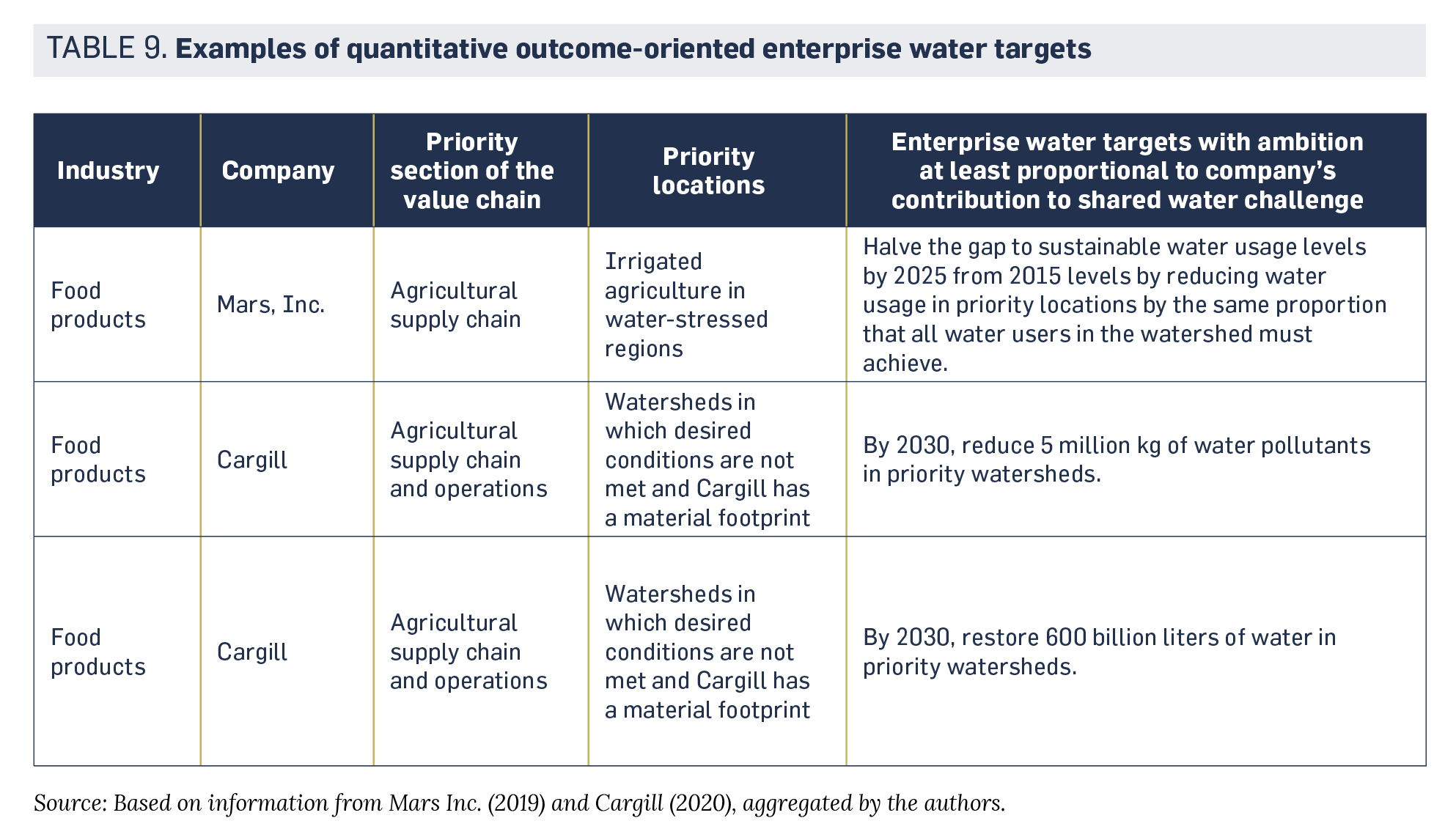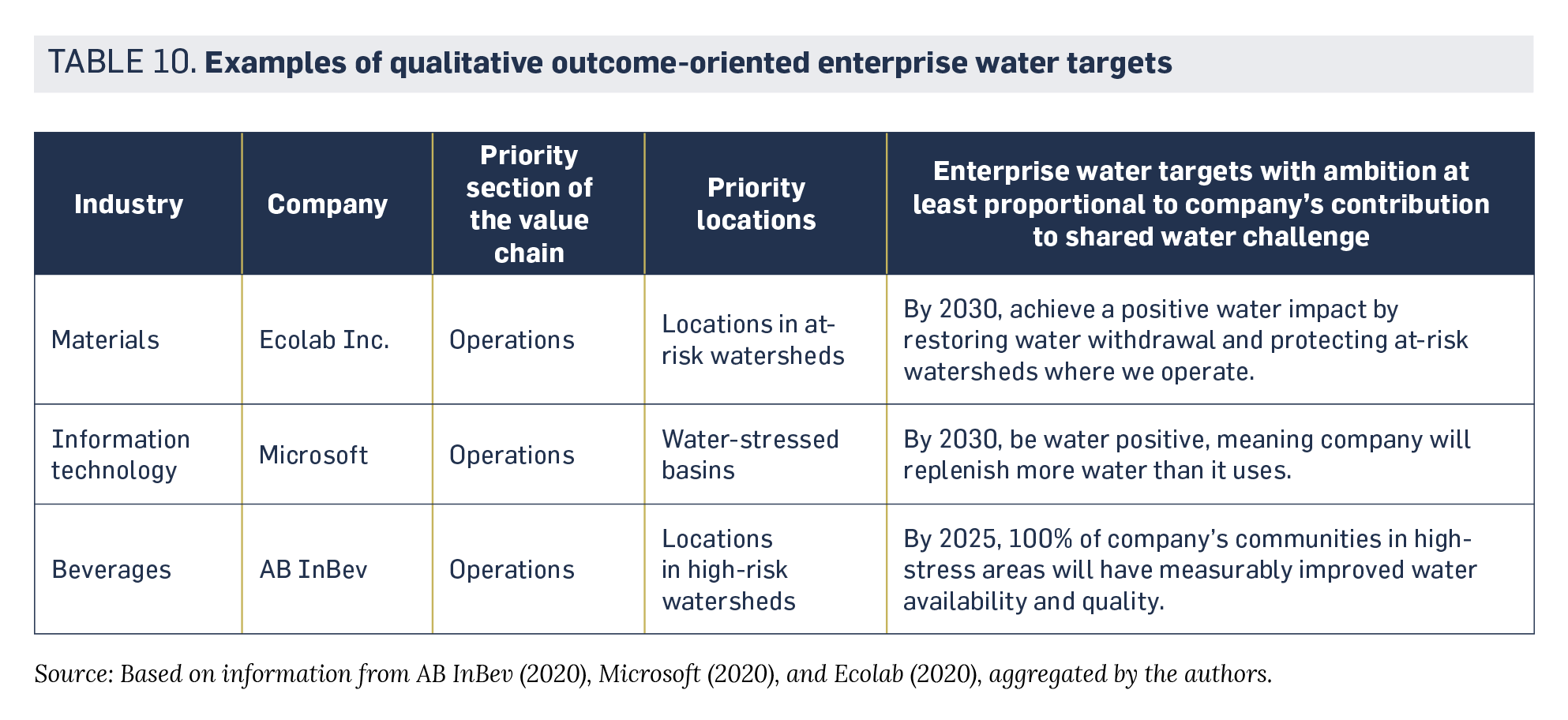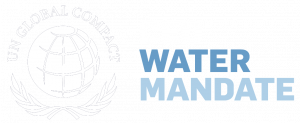Set water targets for the sections of the value chain identified in Step 1 to address the water-related risks and shared water challenges at the locations identified in Step 2. This will help targets deliver both business value by reducing risk and social value by reducing shared water challenges.
A review of current practice indicates that that there are two main ways companies go about setting such proportional targets. First, companies can set outcome-oriented targets that specify, either quantitatively or qualitatively, what the company aims to achieve. Second, companies can specify the processes they intend to use to reduce risk and address shared water challenges. Both outcome- and process-oriented enterprise water targets are applicable to any section of a corporate value chain (Table 6). And both process- and outcome-oriented water targets can effectively reduce water-related risk if they drive actions that respond to the local watershed context in ways that are at least proportional to a company’s contributions to the local shared water challenges.

What type of enterprise water target to set can depend on the company culture, and can vary along different sections of the value chain. For one shared water challenge or section of the value chain, a company might set an outcome-oriented target; for another, a process-oriented target might be more feasible or suitable. The choice may hinge on the company’s industry, access to information, stakeholders’ opinions, geographic distribution, company size, and risk profile, to name a few factors.
Depending on the type of enterprise water target, companies will undertake different steps to determine how ambitious a target to set. The level of ambition should reflect the company’s desire to reduce risk and its sense of responsibility toward addressing shared water challenges. Further, when setting enterprise water targets, companies should assess opportunities to contribute to, or align with, existing corporate and public sector efforts and initiatives driving collective action. This can help reduce the overall cost and effort required of each participant.
In all cases, enterprise water targets should drive measurable improvements at the local level. They should also
- be specific, measurable, achievable, relevant and time-bound;
- maintain accountability, internally and externally;
- encourage others to set similarly ambitious targets;
- attract broad external and internal support;
- undergointernalandexternalreviewwithstakeholderstoensurecredibilityandtransparencybefore finalizing; and
- be understandable to internal and external stakeholders.
PROCESS-ORIENTED ENTERPRISE WATER TARGETS
Setting process-oriented enterprise water targets involves committing to adopting and using specific processes that in turn will drive actions and interventions by the company that reduce risk and contribute to addressing shared water challenges in the local catchment (Table 7). These targets are only as robust as the processes adopted. Whenever possible, companies should consider committing to processes that
- are owned by senior management and integrated into operations;
- establish baseline conditions and institutions, are time limited, and have a scheduled deadline to set appropriately ambitious targets;
- have been developed and reviewed by subject-matter experts(e.g.,water stewardship plans developed by water stewardship practitioners);
- ensure a level of ambition that is aligned with the magnitude of the problem (e.g., watershed targets informed by catchment context and stakeholder consultation); and
- will be trusted by both internal and external stakeholders (e.g., standard processes that can be certified by an independent third party).
Because the commitment is to implementing a process, not to delivering an outcome, process-oriented enterprise water targets offer companies the ability to set a target that can respond to all shared water challenges and are adaptable to a wide range of catchment contexts. However, the limitations of this approach include difficulty in tracking and communicating progress and the effort needed to ensure that the actions taken as a result of the implemented processes actually work as intended. Targets must be aligned with the catchment context and magnitude of shared water challenges and lead to meaningful reductions in risk. Companies can optimize their chances of success by following best practice guidance for setting water targets informed by catchment context (UN Global Compact CEO Water Mandate et al. 2019).

OUTCOME-ORIENTED ENTERPRISE WATER TARGETS
The outcome-oriented approach entails committing to delivering an outcome that contributes to reducing risk and shared water challenges in the local catchment in ways that are at least proportional to a company’s contributions to the shared water challenges. Outcome-oriented enterprise water targets can be quantitative or qualitative.
Quantitative Outcome-oriented Target
Companies can quantify their contributions to shared water challenges using information provided by organizations that manage water resources, such as a catchment commission, water utility, surface water or groundwater board, or water regulatory agency. That may be challenging or impossible to do across an entire portfolio of locations, so companies can also estimate their contributions to the local shared water challenges by using global data sets (Hofste et al. 2019). Once companies estimate how much the current conditions in each catchment will have to change to address the shared water challenge, and how much their own operations have contributed to this challenge, they can arrive at targets.
In the context of enterprise water targets, “desired conditions” refers to reducing or eliminating a water challenge within a predefined geographic area, for example, a catchment or area of influence (UN Global Compact CEO Water Mandate et al. 2019). Clarifying what the desired conditions are helps to answer the question: what would success look like for that shared water challenge? The desired conditions can be defined generically by aligning with international commitments, such as the targets underpinning SDG 6 for water (United Nations 2015), or with agreed-upon outcomes, such as the Alliance for Water Stewardship water stewardship outcomes (Alliance for Water Stewardship 2019). Desired conditions can also be defined locally by using approaches such as basin report cards (Costanzo et al. 2017).
The percentage change in current conditions required to address the shared water challenge and meet the desired conditions can be estimated using the following equation:

Once known, the required percentage change in conditions can be used to set quantitative outcome-oriented enterprise water targets. Companies can apply the required percentage change to their activities to estimate what their contribution to meeting the desired conditions should be at each location. Those targets can then be compiled to track progress across the enterprise (Table 8).

The company’s contribution toward meeting desired conditions across the value chain can be estimated with information procured locally and aggregated up, from observations taken at each location, or globally, by applying estimates from global data sets across the priority locations and value chain sections (Table 9). This will help the company understand both the magnitude of the problem and the required target ambition to close the gap between the current and desired conditions.

Qualitative Outcome-oriented Target
Companies may also choose to set qualitative outcome-oriented targets. In this approach, instead of estimating their contribution to meeting the desired conditions at each location, companies provide a description of the outcome they aim to achieve (Table 10).

Outcome-oriented enterprise water targets allow companies to specify targets at both the enterprise and site levels and thus provide a goal for practitioners across the value chain. One strength of this approach is the scalability of the method across large portfolios of locations using global data sets that are readily available in the public domain.
The disadvantages of this approach include the need for multiple targets to address the shared water challenges at each location and the need to know all the locations included in the target. Another difficulty is that if the targets are applied on the basis of global data sets, it can be difficult to build trust and ownership at the site level across large portfolios of locations without prior engagement or consultation with local stakeholders.
These limitations can be overcome by procuring site data to inform outcome-oriented water targets that can be aggregated across sites up to the enterprise level, following guidance for setting site water targets informed by catchment context (UN Global Compact CEO Water Mandate et al. 2019). Not relying on global data sets gives the company’s sites an opportunity to contribute and build ownership of the commitment to the targets. However, procuring data from sites is far more time intensive than using available data sets and it requires direct access to each location, something that can be very challenging when setting targets in supply chains or across large portfolios of sites.
Companies should develop an implementation strategy and a plan to identify, assign metrics to, and secure the required resources to meet the enterprise water targets.
To measure progress toward achieving targets, companies should define and use specific metrics that are linked to a detailed plan of actions to be taken, with buy-in from internal and external stakeholders. Each company has its own methods of monitoring and evaluation. These should be integrated into the company’s performance evaluation process. They should also reflect leading practice and align with each company’s reporting and disclosure requirements to drive meaningful action at the catchment scale.
If enterprise water targets are to deliver meaningful actions at the catchment level, companies should
- meet targets by collaborating with other stakeholders to accelerate the achievement of desired conditions (UN Global Compact CEO Water Mandate 2013);
- deliver co-benefits through water-related interventions that contribute to meeting other priorities, such as economic needs (e.g., new revenue streams), social needs (e.g., new jobs), or environmental priorities (e.g., climate initiatives);
- revisit targets and the implementation strategy periodically to ensure both remain relevant to addressing the most critical challenges, especially as more information and data become available and changes in companies’ business practices and in water resources inevitably occur; and
- account for and communicate progress toward meeting the targets using credible methods (Reig et al. 2019).
